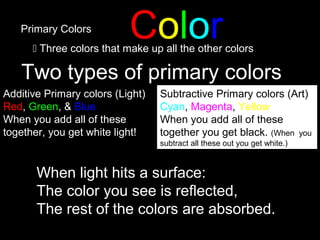Physics Color Notes
•
2 gefällt mir•12,873 views
Basic notes on Light and Color
Melden
Teilen
Melden
Teilen
Downloaden Sie, um offline zu lesen

Empfohlen
Weitere ähnliche Inhalte
Was ist angesagt?
Was ist angesagt? (10)
Part 3 how to make simple tarpulin in adobe photoshop cs6

Part 3 how to make simple tarpulin in adobe photoshop cs6
Andere mochten auch
Andere mochten auch (13)
Ähnlich wie Physics Color Notes
Ähnlich wie Physics Color Notes (20)
Creative Industry Lecture 2 a b color form and space

Creative Industry Lecture 2 a b color form and space
SILICA Study Material Kit (Book # 4) COLOR lecture book

SILICA Study Material Kit (Book # 4) COLOR lecture book
Mehr von cpphysicsdc
Mehr von cpphysicsdc (19)
AP Electrostatic & Equipotential Sample Problems

AP Electrostatic & Equipotential Sample Problems
Kürzlich hochgeladen
BÀI TẬP BỔ TRỢ TIẾNG ANH 8 - I-LEARN SMART WORLD - CẢ NĂM - CÓ FILE NGHE (BẢN...

BÀI TẬP BỔ TRỢ TIẾNG ANH 8 - I-LEARN SMART WORLD - CẢ NĂM - CÓ FILE NGHE (BẢN...Nguyen Thanh Tu Collection
Chi-Square Test Non Parametric Test Categorical Variable

Chi-Square Test Non Parametric Test Categorical VariableNigar Kadar Mujawar,Womens College of Pharmacy,Peth Vadgaon,Kolhapur,416112
Team Lead Succeed – Helping you and your team achieve high-performance teamwo...

Team Lead Succeed – Helping you and your team achieve high-performance teamwo...Association for Project Management
BÀI TẬP BỔ TRỢ TIẾNG ANH 11 THEO ĐƠN VỊ BÀI HỌC - CẢ NĂM - CÓ FILE NGHE (GLOB...

BÀI TẬP BỔ TRỢ TIẾNG ANH 11 THEO ĐƠN VỊ BÀI HỌC - CẢ NĂM - CÓ FILE NGHE (GLOB...Nguyen Thanh Tu Collection
Plagiarism,forms,understand about plagiarism,avoid plagiarism,key significanc...

Plagiarism,forms,understand about plagiarism,avoid plagiarism,key significanc...Nigar Kadar Mujawar,Womens College of Pharmacy,Peth Vadgaon,Kolhapur,416112
Kürzlich hochgeladen (20)
BÀI TẬP BỔ TRỢ TIẾNG ANH 8 - I-LEARN SMART WORLD - CẢ NĂM - CÓ FILE NGHE (BẢN...

BÀI TẬP BỔ TRỢ TIẾNG ANH 8 - I-LEARN SMART WORLD - CẢ NĂM - CÓ FILE NGHE (BẢN...
Unraveling Hypertext_ Analyzing Postmodern Elements in Literature.pptx

Unraveling Hypertext_ Analyzing Postmodern Elements in Literature.pptx
Indexing Structures in Database Management system.pdf

Indexing Structures in Database Management system.pdf
Chi-Square Test Non Parametric Test Categorical Variable

Chi-Square Test Non Parametric Test Categorical Variable
Healthy Minds, Flourishing Lives: A Philosophical Approach to Mental Health a...

Healthy Minds, Flourishing Lives: A Philosophical Approach to Mental Health a...
How to Uninstall a Module in Odoo 17 Using Command Line

How to Uninstall a Module in Odoo 17 Using Command Line
Team Lead Succeed – Helping you and your team achieve high-performance teamwo...

Team Lead Succeed – Helping you and your team achieve high-performance teamwo...
BÀI TẬP BỔ TRỢ TIẾNG ANH 11 THEO ĐƠN VỊ BÀI HỌC - CẢ NĂM - CÓ FILE NGHE (GLOB...

BÀI TẬP BỔ TRỢ TIẾNG ANH 11 THEO ĐƠN VỊ BÀI HỌC - CẢ NĂM - CÓ FILE NGHE (GLOB...
DBMSArchitecture_QueryProcessingandOptimization.pdf

DBMSArchitecture_QueryProcessingandOptimization.pdf
Plagiarism,forms,understand about plagiarism,avoid plagiarism,key significanc...

Plagiarism,forms,understand about plagiarism,avoid plagiarism,key significanc...
BIOCHEMISTRY-CARBOHYDRATE METABOLISM CHAPTER 2.pptx

BIOCHEMISTRY-CARBOHYDRATE METABOLISM CHAPTER 2.pptx
Employablity presentation and Future Career Plan.pptx

Employablity presentation and Future Career Plan.pptx
Q-Factor General Quiz-7th April 2024, Quiz Club NITW

Q-Factor General Quiz-7th April 2024, Quiz Club NITW
The role of Geography in climate education: science and active citizenship

The role of Geography in climate education: science and active citizenship
Physics Color Notes
- 1. ColorPrimary Colors Three colors that make up all the other colors Two types of primary colors Additive Primary colors (Light) Red, Green, & Blue When you add all of these together, you get white light! Subtractive Primary colors (Art) Cyan, Magenta, Yellow When you add all of these together you get black. (When you subtract all these out you get white.) When light hits a surface: The color you see is reflected, The rest of the colors are absorbed.
- 2. (If you have a projector and a couple of mirrors, you can also project the slide and reflect the primary colors on top of each other to see the secondary colors.) The computer screen uses RGB (Red, Green, Blue) to show colors. By adjusting the colors of the circles, you can see the different combinations of primary light colors.
- 3. ColorPrimary Colors Three colors that make up all the other colors Two types of primary colors Additive Primary colors (Light) Red, Green, & Blue When you add all of these together, you get white light! Subtractive Primary colors (Art) Cyan, Magenta, Yellow When you add all of these together you get black. (When you subtract all these out you get white.)
- 4. Red Again, if you have a projector, project this on a wall and get different colored objects and see how they look under different colored light! Make sure your room is completely dark. Key Idea: The color you see is the reflected color. If the paint and the light share the same color, you’ll see it. If they don’t, it will look black.So •Blue light on purple will look blue because purple is made of blue and red. •Blue light on green will look blue because green is blue and yellow. •Blue light on red will look black because red doesn’t have any blue pigment to reflect the blue light.
- 5. Red The rods and cones in your eyes allow you to see. Rods detect brightness. 120 million rods in your eyes. Cones detect color: 3 types: R, G, B 6 million cones in your eyes.
- 6. Red The rods and cones in your eyes allow you to see. Rods detect brightness. 120 million rods in your eyes. Cones detect color: 3 types: R, G, B 6 million cones in your eyes.
Hinweis der Redaktion
- Folders.